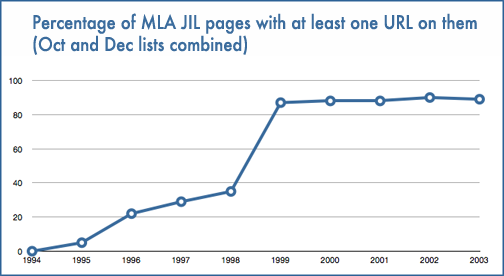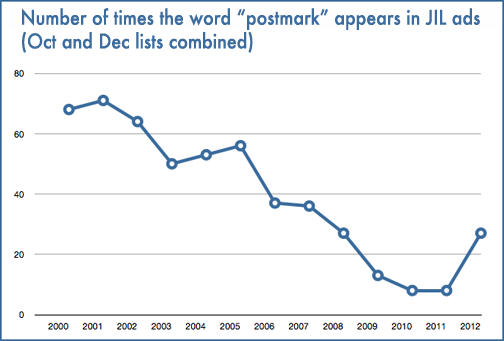This week, in Rhetoric, Composition, and Digital Humanities, we’re reading a series of essays about metadata, so that’s where my mind has been as of late. And one of the things that I’m asking my students to do each week is to imagine projects that they might do based upon the readings and resources for that week. So I spent a little time this afternoon messing around with the fabulous dataset that Jim Ridolfo has shared, the OCRed archive of MLA Job Information Lists.
I wanted to do something that had some kind of hypothesis, but also that I could do fairly quickly, without too much technological overhead. I settled for the question of how the job search process has changed over the past 10-15 years with respect to technology. When I was on the market for the first time, in 1997 (!!), I don’t recall whether the online version of the JIL had been introduced yet. But certainly the job seeker’s experience, even allowing for the online JIL, was predominantly paper-based.
I don’t think it’s particularly earth-shattering to suggest that this has changed. But can we find that change reflected in the JIL itself? I tried a couple of angles. First, I tracked all mentions of the word “postmark” (including postmarked). I was working mostly with basic pagecounts, and while I tried to be good about eliminating those few occasions where it appeared twice in one ad, I almost certainly missed some of them. I also combined the October and December JILs, so if an ad appeared in both with the word, I counted it twice, I’m afraid. This is a blogpost.
The only surprising thing about this graph to me is the little uptick in 2012, after references to postmarking had dropped into the single digits rather quickly from 2009-2011. Otherwise, though, this was about what I’d expect. As more institutions set up online HR forms and began to accept materials delivered electronically, the idea of indicating a separate postmark (as opposed to a simple deadline) has been on the decline.
The second approach I took was to look into how many job ads made reference to URLs, either in the form of departmental homepages or online (HR) submission forms. Given the steep climb from 1998 to 1999, you might forgive me for deciding not to count after a certain point. Instead, what I’ve done here is in terms of percentages. The JIL has front matter that stays pretty constant, so there are no URLs on those pages, making the maximum somewhere in the 90% range. I did a basic search count for “http,” then divided the # of page hits by the total number of pages in the JIL to arrive at these percentages. I also went backwards until I found a year (1994) with zero.

A line graph charting the percentage of JIL pages with at least one URL on them, 1994-2003.
This graph is a little misleading, though, going as it does from around one-third of the JIL pages in 1998 to nearly all of them in 1999. If I remember correctly, 1999 was the first year where participating departments were prompted to supply a homepage for their program and so, even if the ad copy doesn’t reference any URLs, the ad itself contains one. Were I to strip out those headings, the graph might be more gradual, and more accurate in its representation of the diffusion of the web into the JIL.
I know you’re curious. The five institutions that supplied URLs in 1995 were Clemson, Georgetown, Oregon State, Western Michigan, and an organization in Austria called the International Institute for Applied Systems Analysis.
Neither of these graphs necessarily lead to grand claims about the effect of the internet on the job search process. The second does suggest a point at which it was taken for granted that programs would have some rudimentary web presence. The first suggests that we’ve seen a gradual tailing-off of certain print- and postal-based assumptions about how materials circulate. And both suggest that if I wanted to claim anything more specific, I’d need to do much finer-grained work first.
That’s all.

Article Comments